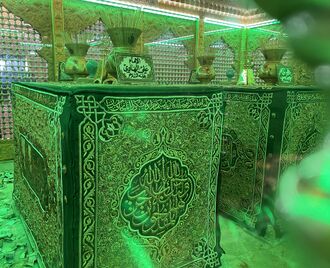Main Page

Muḥammad b. Abī Bakr b. Abī Quḥāfa (Dhu l-Qa'da 10/February 632–Safar 38/July 658) was one of the closest companions of Imam Ali (a), appointed by him as the governor of Egypt.
He was the son of the first caliph and Asma' bt. 'Umays, but after the demise of Abu Bakr, his mother married Imam Ali (a) and thus Muhammad was raised in the Imam's (a) home. The Imam (a) loved him and regarded him as his own son. The place that he had in the Imam's (a) heart is sometimes compared to that of Abu Dhar in the heart of the Prophet (s).
He was one of the prominent critics of the conduct of 'Uthman, the third caliph. During the caliphate of Imam Ali (a), he was one of the Shurtat al-Khamis and the commander of a section of the Imam's (a) army in the battles of Jamal and Siffin. He is praised in historical and hadith sources. He was martyred when the Syrian army invaded Egypt.
Muhammad b. Abi Bakr was born in Dhu l-Qa'da, 10 / February, 632 in a place called Dhu l-Hulayfa (18 km from Medina on the way to Mecca), when the Prophet (s) was on his way to Mecca for his last Hajj. His father, Abu Bakr, was the first caliph after the Prophet (s). He passed away when Muhammad was only two years and several months old. His mother, Asma' bt. 'Umays, was one of the prominent women of early Islam. She was first married to Ja'far b. Abi Talib, and after the martyrdom of Ja'far, she married Abu Bakr.
After the death of Abu Bakr, Asma' Married Imam 'Ali (a) and thus Muhammad came to live and be raised by the Imam (a). Muhammad was closely acquainted with the Imam's (a) lifestyle and character, which made him love the Imam (a) abundantly. The Imam (a) also loved Muhammad and would call him "My son". In Nahj al-balagha, it is reported that the Imam (a) said, "He was my friend, and I raised him like my own child."
Most sources of early Islamic history acknowledge Muhammad's honesty, righteousness, and nobility. According to a hadith, "Although he [i.e., Muhammad] was not of the Ahl al-Bayt (a), he was a noble person like them; he was the blest and purest person among his own family"......
Other featured articles: Miqdad b. Amr – Usul al-Din – Event of Ghadir
- ... Fasting started to be an obligatory task for every Muslim in 2 AH.
- ... Did you know that the Ja'fari madhhab is referred to as Twelver Shia because the foundations of the school, its expansion, and the development of Shia jurisprudence were primarily established during the period of Imam Ja'far al-Sadiq (a)?
- ... many Shia authorities such as Khamenei, al-Sistani, Wahid Khurasani and Tabrizi consider the People of the Book (Christians, Jews and Majus) pure (tahir). (see: najis)?
- Sura al-Kawthar «The 108th and shortest chapter of the Qur’an, revealed in Mecca. Shi'a scholars often interpret "al-Kawthar" as including Lady Fatima (a) and her children, highlighting her role as the Prophet’s progeny.»
- Imam al-Hasan al-'Askari (a) « was the eleventh Imam of Twelver Shi'a and the father of Imam al-Mahdi (a).»
- Minor Occultation «The period from 260/874 to 329/941 when Imam al-Mahdi (a) was hidden from the public but communicated with his followers through the four deputies.»
- Sayyid Hassan Nasrallah «was a Lebanese Shia cleric and the Secretary General of Hezbollah, a Shia Islamic political and military organization based in Lebanon.»
- Fatima al-Ma'suma (a) «well known as Fatima al-Ma'suma (a) is the daughter of Imam al-Kazim (a) and sister of Imam al-Rida (a).»
- Imami Theology «is one of the theological schools in Islam, which relies in its method and sources on the Qur’an, the Sunnah of the Prophet (s), the infallible Imams (a), and rational reasoning. Its most distinguishing feature is the belief in the issue of Imamate»
- Hezbollah (Lebanon) «is a Shia Islamic political and military organization that was founded in Lebanon in 1982. Its primary objective was to resist the occupation of the Zionist regime.»
- Imam al-Hasan b. Ali al-Mujtaba (a) «The second Imam of Shi'a Islam and grandson of the Prophet Muhammad (s).»
- Martyrdom «is to be killed on the path of God, which is referred to in hadiths as the greatest good and the most honored death. Quranic verses and hadiths attribute effects to martyrdom such as staying alive, having the right for intercession, and forgiveness of sins.»
- Aqila Bani Hashim (epithet)
- Kafir
- Kafir al-muhadin
- Al-I'tisam Verse
- Abdulaziz Sachedina
- Israel (epithet)
- Alimatun ghayru mu'allama
- Al‑Jar thumma al‑Dar
- Zahra (epithet)
- Sariyya of Imam Ali (a) in Yemen
- Marriage of the Prophet (s) with Zaynab bt. Jahsh
- Insha Allah
- Demise of the Prophet (s)
- Hadith of I and the Hour
- Laylat al-Harir
- Sermon of Laylat al-Harir
- Inheritance
- People of al-Aykah
- People of Saba'
- Defensive jihad
Today Tuesday, 9 December, 2025 / 18 Jumada II, 1447
- 1913 CE – Birth of Sayyid Abd al-Husayn Dastghayb (Muharram 10, 1332 AH)
- 1976 CE – Demise of Haj Aqa Rahim Arbab (Dhu l-Hijja 17, 1396 AH)
- 1979 CE – Demise of Muhammad Jawad al-Mughniya, Shiite exegete and clergy and the head of the Lebanese judiciary, (Muharram 19, 1400 AH).
- 1993 CE – Demise of Sayyid Muhammad Rida Gulpaygani (Jumada II 24, 1414 AH)
- 1019 AH - Martyrdom of Qadi Nur Allah Shushtari (September 7, 1610)
- 1281 AH - Demise of al-Shaykh Murtada al-Ansari (November 18, 1864)
- 1405 AH - Demise of Sayyid Husayn Khadimi (March 11, 1985)
- 1442 AH - Demise of Al-Sayyid Muhammad Sa'id al-Hakim (February 1, 2021)



